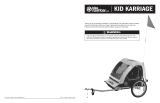
18
Burley Solo Owner’s Instruction and Safety Manual
Ride on Clean, Paved Surfaces
Your Burley Solo is not intended for off-road use. Towing a child off road can be espe-
cially dan ger ous. Any bumps or ir reg u lar i ties could cause tip over and serious in ju ry
to the bicyclist or pas sen ger, or damage to the trailer.
Cross over railroad tracks, curb cut outs, and road grooves at 90˚. Riding parallel or at
acute angles to such obstacles can cause a crash.
Riding When It’s Slippery
Be especially careful in wet, rainy, or freezing conditions. Your abil i ty to control and
stop your bi cy cle when towing a trailer is greatly im paired. In wet con di tions apply
your brakes periodically to be sure the rims and brake pads are clear of water. Avoid
forceful braking which can cause dan ger ous skid ding. Ride slowly and allow a
greater margin of safety when starting, stop ping, and turning.
Do not ride on surfaces where sand, gravel, ice, oil, or other slippery substances are
present; if you must pass over slippery surfaces, walk your bike and trailer.
Navigating Curbs, Stairs, and Escalators
Never tow your trailer over curbs; rider must dismount and walk over any curbs. If
you must traverse stairs, prevent a hazardous loss of control: have the children get
out of the trailer and disconnect it from the bike; carefully roll your trail er and bike,
in de pen dent ly, up or down the stairs. Never take your bike or trailer on escalators.
Use Cautiously with Pets
Your trailer is not designed to secure pets. A cat or other small pet can be towed
if they are in a pet carrier secured to the trailer frame. A sedate dog can be towed
seated on the trailer fl oor: add carpet for comfort, always use a cover, and do not
exceed 100 lbs. Never tow an excitable dog in your trailer, as it may lunge or try to
jump out causing tip over or other accident.
Avoid Riding at Night
Make every effort to schedule your rides so you are not pulling a trailer at night.
Because your ve hi cle is longer and heavier you will be less able to react to unseen
hazards. Automobile drivers may not be accustomed to your longer vehicle and may
not react to it appropriately. If you must ride at night, wear bright, refl ective clothing,
use a bright headlight and a red blinking taillight on your bike. Similarly, put a red
blinking light in the light-holder tab sewn onto the back of your cover so you can
be more easily seen. Do not operate without properly attached re fl ec tors; replace
cracked or missing refl ectors.
Always Use Your Cover
Affi x your Big Screen 2-in-1 Cover to protect your child from fl ying debris when
pulling your trailer. Never leave a child unattended in direct sunlight because heat






















